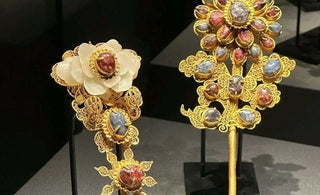
The Fusion of Art and Literature
The fusion of art and literature is a harmonious marriage of creative expressions. In the context of Asian culture, this interplay becomes even more profound, as the visual arts and written word intertwine to create a vibrant tapestry of inspiration. Asian artists, with their skillful brushwork and attention to detail, create captivating visual masterpieces that ignite the imaginations of writers. These literary creators, in turn, weave stories that reflect the beauty and essence of these artistic expressions. The fusion of art and literature not only enhances the individual works but also creates a synergy that transcends boundaries, fostering a deeper appreciation for both mediums and enriching the artistic landscape as a whole.
The Allure of Asian Art in Fiction
The allure of Asian art in fiction lies in its captivating allure and timeless appeal. The rich history, diverse themes, and exceptional craftsmanship found in Asian art serve as a wellspring of inspiration for literary creations. Ancient myths, historical events, and personal anecdotes depicted in Asian artworks become fertile ground for writers to weave intricate narratives. The vivid imagery, symbolism, and cultural nuances present in these art forms offer a unique and immersive experience for readers. The allure of Asian art in fiction lies in its ability to transport readers to mystical realms, evoke deep emotions, and provide a profound appreciation for the beauty and cultural significance of these artistic expressions.
Unveiling Symbolism
Asian art is renowned for its symbolism and visual storytelling. Traditional paintings often convey profound meanings through the use of symbols, motifs, and brushwork techniques. Each stroke and color choice is deliberate, imbued with layers of cultural and philosophical significance. This symbolism finds its way onto the pages of literature, breathing life into characters, settings, and narratives. Writers draw inspiration from the visual language of art, infusing their storytelling with vivid descriptions and poetic imagery. The result is a harmonious fusion of artistic mediums, where the brushstrokes of a painting come alive through the evocative power of words.
Asian Art as Muse
Asian art, with its mesmerizing beauty and profound symbolism, has served as an enduring muse for countless writers throughout history. From the delicate brushwork of Chinese ink paintings to the vibrant colors of Japanese woodblock prints, these visual masterpieces ignite the imagination and inspire literary creations. The serene landscapes, graceful figures, and intricate details depicted in Asian art become sources of inspiration, shaping characters, settings, and narratives in literature. Writers find solace and creative fuel in the evocative power of these artworks, drawing upon their aesthetic qualities and cultural significance to craft stories that resonate with readers on a deep and profound level. Asian art serves as a muse, guiding writers on a journey of artistic exploration and self-expression.
Exploring Cultural Heritage
Exploring cultural heritage through Asian art is a transformative experience that allows writers to delve into the depths of history, mythology, and societal values. Each stroke and symbol within these artworks carries the weight of centuries of tradition and storytelling. By immersing themselves in the visual narratives depicted in Asian art, writers gain a profound understanding of the cultural nuances, traditions, and values that shape Asian societies. They breathe life into characters, settings, and events, painting a vivid picture of ancient kingdoms, mythological realms, and pivotal historical moments. Through literature, readers are transported across time and space, forging a deeper connection with Asian culture and fostering a greater appreciation for its profound impact on the world.
The Influence of Asian Art Movements
The influence of Asian art movements on literature cannot be overstated. Each art movement brings with it a distinct aesthetic and philosophical perspective that resonates with writers. The delicate and introspective nature of the Song Dynasty's "Blue and Green Landscape" paintings, for example, has inspired narratives exploring themes of contemplation, nature's beauty, and the human connection to the environment. The bold and vibrant colors of the Edo period's Ukiyo-e prints have influenced stories centered around the bustling urban life, tales of geishas, and the world of samurais. These art movements serve as catalysts for creativity, shaping narratives, characters, and atmospheres, and leaving an indelible mark on the literary landscape. The influence of Asian art movements breathes life into literature, infusing it with the spirit and essence of these remarkable artistic expressions.
Oriental Aesthetics: Celebrating the Interplay
At Oriental Aesthetics, we celebrate the captivating interplay of Asian art and literary creations. Our company is dedicated to providing systematic, high-quality professional services for oriental artists, collectors, and enthusiasts. We understand the profound connection between art and literature and strive to create a platform where these two mediums converge, offering a holistic experience for art lovers and literary enthusiasts alike.
In the realm of Asian art in fiction, the brushstrokes on canvas become the literary brushstrokes that paint vivid worlds and unforgettable characters. The fusion of art and literature creates a rich tapestry of inspiration, where the visual narratives of Asian art come alive through the power of words. Oriental Aesthetics, with its commitment to preserving and promoting classical oriental art, invites you to immerse yourself in this enchanting world. Discover the transformative power of Asian art in fiction and embrace the beauty, symbolism, and cultural significance that these artistic expressions convey.
























